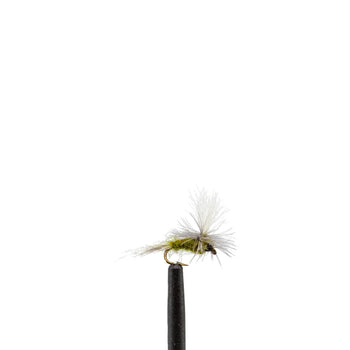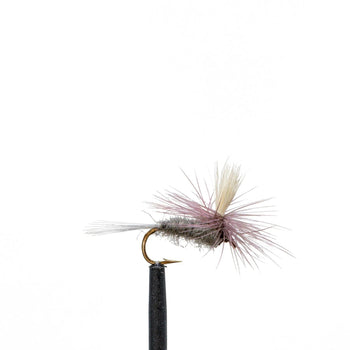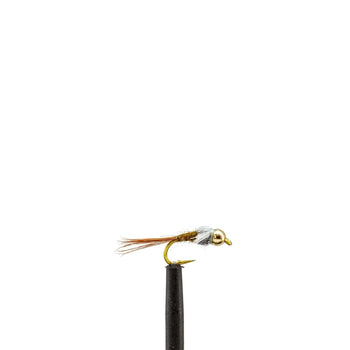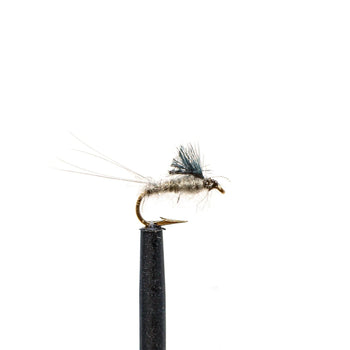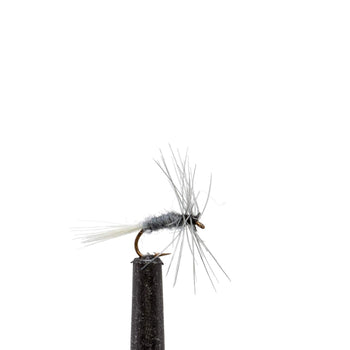Fly of the Month: The Blue-Winged Olive (BWO) – Match the Hatch from Nymph to Spinner

Few insects command as much respect in fly fishing as the Blue-Winged Olive (BWO). More than just another mayfly pattern, the BWO has been outsmarting trout since the Victorian era—first documented by Frederic Halford in his 1897 masterpiece, Dry Fly Entomology. While early tiers modeled these flies after Ephemerella mayflies, today's most effective patterns imitate the prolific Baetis genus, instantly recognizable by their olive-hued bodies and delicate bluish-gray wings.
Measuring just 10–14 mm, these slender mayflies wear subtle olive to gray-green tones, with translucent wings that catch the light like stained glass. Their most distinctive feature? Two to three graceful tails that flutter behind them as they dance on the water's surface. Unlike flashy summer hatches, BWOs thrive in moody, overcast conditions, often emerging in such numbers that they turn selective trout into reckless gluttons.
What makes BWOs truly extraordinary is their ubiquity and adaptability. From the rocky freestone rivers of the Rockies to the limestone spring creeks of the East, they thrive wherever cold, oxygen-rich water flows. Whether it's the tailwaters of the San Juan or the meandering brooks of Appalachia, BWOs provide year-round sustenance for trout—making them an indispensable hatch for anglers everywhere.
The Secret Life of BWOs: A Trout's Four-Course Meal
To consistently fool trout during a BWO hatch, you need to think like a fish—and that means understanding every vulnerable moment in the mayfly's life. Unlike dramatic salmonfly spectacles, BWOs play out their lifecycle with subtle precision, offering trout four distinct feeding opportunities. Master each stage, and you'll unlock year-round success.

1. Egg Stage: The Beginning (Days to Weeks)
The cycle starts when female BWOs perform their final, fatal dance—skimming the surface to deposit eggs before collapsing into the current. These tiny amber beads (smaller than a pinhead) sink and adhere to rocks, where they'll incubate for days or weeks depending on water temperature. While not a direct feeding opportunity, finding egg-laying sites reveals where future generations will thrive.
📌 Pro Tip: Look for spinner falls near:
-
Slow-moving tailouts
-
Foam lines along banks
-
Sheltered back-eddies
2. Nymph Stage: The Trout's Pantry (10+ Months)
For 90% of their lives, BWOs exist as streamlined nymphs, darting between riverbed gravel like underwater ghosts. These olive-colored mini-athletes:
-
Cling to rocks in fast currents
-
Feed on algae and micro-organisms
-
Molt 20+ times before emerging
Their greatest vulnerability? The ascent to the surface. In the days before hatching, nymphs drift helplessly upward—triggering explosive feeding frenzies.
Deadly Patterns:
-
Pheasant Tail Nymph (dead-drifted deep)
-
Tungsten Perdigon (sinks like a stone)
-
RS2 (suspended mid-column)
3. Emerger Stage: The Surface Drama (Minutes)
As BWO nymphs reach the surface, they begin their transformation—but not all make it. Caught in the meniscus, these emergers are half-in, half-out of their shucks, struggling to break free. This moment of vulnerability is a feast for trout.
Key Strategies:
-
Fish CDC emergers right in the film
-
Use unweighted RS2s or WD-40s for subtle takes
-
Watch for “bulging” rises signaling subsurface eats
4. Dun Stage: The Escape (Seconds to Minutes)
Successful emergers transform into adult duns, drifting briefly on the surface as their wings dry. They’re small, light, and easily knocked down by wind or current.
Prime Tactics:
-
Present Blue-Winged Olive parachutes with long leaders
-
Match the hatch with size #18–22 patterns
-
Fish slow seams and soft current edges for risers
5. Molting to Spinner: Aerial Transition (Hours to Days)
Once airborne, duns molt into sexually mature spinners. This transition occurs off-water—typically in nearby vegetation—and can take hours to a day depending on weather. While not fishable, it sets the stage for the spinner fall.
📌 Pro Tip: A lull in rising activity after a hatch often means duns are molting. Be patient—spinners may return at dusk.
6. Spinner Return: The Final Flight (Dusk)
Mature female spinners gather in swarms above the water. As twilight deepens, they descend to lay eggs, often dipping or crashing onto the surface. Their transparent wings splay outward as they drift in flat water.
Evening Tactics:
-
Use spent-wing dry flies (size #20–24)
-
Focus on slow eddies and foam lines
-
Present with a downstream drift for realism
7. Spent Spinner: End of the Cycle
After laying eggs, female spinners collapse onto the water, wings outstretched. They form mats in eddies and slicks where trout rise subtly, sipping them like shadows.
Presentation Tips:
-
Fish light-bodied Comparaduns or tied-down spinners
-
Use 6X tippet and long leaders
-
Cast downstream with minimal drag

Understanding the BWO Hatch: Timing & Conditions
Success during a BWO hatch is all about timing, observation, and preparation. Blue-Winged Olives are known for their long, sporadic emergence windows, and while they may not hatch in overwhelming numbers like some larger mayflies, trout often lock in on them with single-minded focus. These hatches are most reliable during cool, overcast days—often when little else is happening—which makes them a favorite among anglers who fish throughout the shoulder seasons.
When & Where to Find Them
Few mayflies match the Blue-Winged Olive's remarkable adaptability across diverse waters. These prolific insects thrive wherever cold, oxygen-rich currents flow, making them a dependable hatch across three distinct river types:
Freestone Streams
The classic BWO habitat, where snowmelt and rainfall create dynamic conditions:
• Mountainous watersheds with rocky bottoms
• Best during spring snowmelt (March-May) and autumn cooling (September-November)
• Key spots: Slower side channels, foam lines below riffles, and sheltered banks
Spring Creeks
The BWO's year-round home, offering ideal stable conditions:
• Constant temperatures support continuous life cycles
• Predictable hatches even in summer's heat and winter's chill
• Productive areas: Weed bed edges, smooth glides, and spring-fed tributaries
Tailwaters
Where BWOs become winter warriors:
• Dam-controlled flows maintain perfect water temperatures
• Surprisingly strong hatches during cold months
• Hotspots: Transition zones between fast and slow water, bubble lines, and shelf pools
Seasonal Patterns That Matter
BWOs follow nature's subtle cues rather than strict calendars:
• Early Spring (March-April): First significant emergence in many systems, especially productive in Western rivers like Utah's Green River
• Fall (September-November): Often the most intense hatches as water cools and days shorten
• Winter (December-February): Tailwaters shine with midge-BWO combinations keeping trout active
The Perfect BWO Conditions
These insects have distinct preferences that trigger activity:
☁ Cloud cover is king - Overcast skies consistently produce the heaviest emergences
☔ Drizzle improves everything - Light rain boosts surface activity and extends hatches
ᴿ Temperature sweet spot - 45-65°F air temps are ideal, with morning/evening being most reliable
Size Variations Through the Year
• Spring/Fall: #16-20 (larger profiles for stronger hatches)
• Winter: #22-24 (tiny but crucial in cold water)
• Regional differences: Western BWOs often run larger than Eastern counterparts
Locating Active Hatches
Follow these oxygen-rich zones where BWOs congregate:
-
Riffle edges and bubble lines
-
Heads of pools where current meets still water
-
Seams along bankside vegetation
-
Tailouts with moderate current
The BWO's true brilliance lies in its ability to thrive where other mayflies falter. From crashing freestone rapids to serene spring creek flats, these adaptable insects provide year-round opportunities for observant anglers. By understanding their preferred habitats and seasonal rhythms, you'll always know where to find both the flies and the trout that hunt them.
Top BWO Fly Patterns & How to Fish Them
A well-stocked BWO arsenal covers every stage of the hatch—from deep nymphing to delicate dry-fly presentations. Below, we’ve broken down the most effective patterns for each phase.
Dry Flies: Matching the Adult Stage
These flies imitate the adult stage of the Blue-Winged Olive, when they float on the water's surface with wings upright. They’re most effective during peak hatch activity when trout are rising confidently.
Blue-Winged Olive - Dry Fly (Sizes 16–20) – A traditional upright-wing BWO imitation that floats cleanly on the surface. Excellent for matching the adult stage when fish are confidently rising. Fish it alone with a drag-free drift over rising trout in clear seams and pools.
Blue-Winged Olive Parachute (Sizes 16–20) – The parachute post increases visibility while keeping the fly low in the surface film. Great for riffles or broken water. Use a long leader and present naturally through current transitions.
Blue-Winged Olive Wulff (Sizes 16–18) – A bushier, high-floating dry that performs well in fast-moving or choppy water. Fish it upstream with regular mends in pocket water and freestone runs.
Blue Dun Parachute (Sizes 16–20) – An ideal match for smaller Baetis and midges in low-light or cloudy conditions. Best fished with light tippet and a downstream slack-line presentation.
📌 Pro Tip: Carry a variety of BWO dries—from flush-riding parachutes to high-floating Wulffs—to match water conditions and fish preferences. Fish are often more willing to rise when your fly is easy to track and rides naturally in the current.
Emergers: The Most Productive Stage
Emerger patterns mimic insects rising through the water column or caught in the surface film—often the most vulnerable and most targeted stage by trout.
Beadhead BWO Emerger (Sizes 18–22) – Imitates the transitional stage between nymph and adult. Drift it just under the surface, or allow it to swing up gently at the end of a drift.
RS2 (Sizes 18–22) – A versatile emerger available in standard and beadhead styles. Ideal for tailwaters and technical water. Fish near the surface or deeper depending on trout behavior.
Blue Dun Midge (Sizes 20–24) – Imitates a midge or very small Baetis emerger. Grease the leader and let it drift just below the film; effective during subtle surface activity.
WD40 (Olive, Black, or Dun) (Sizes 18–22) – A sparse, simple pattern that excels during light hatches or in clear water. Use as a dropper beneath a dry or swing gently through soft seams.
📌 Pro Tip: When trout are mid-column or suspended near the surface, try pairing a beadhead emerger with an unweighted version for a natural, layered presentation that covers both levels of the strike zone.
Nymphs: Pre-Hatch & Deep Feeding
Nymph patterns are essential for covering the early and subsurface stages of a BWO hatch, particularly before fish begin rising.

|

|

|
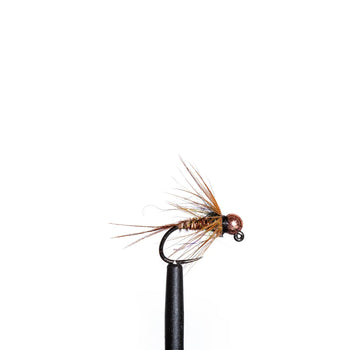
|
| Pheasant Tail Nymph |
Tungsten Bead Perdigon Jig - Olive |
Beadhead Hare’s Ear Flashback | Beadhead Soft Hackle Pheasant Tail |
Pheasant Tail Nymph (Sizes 16–20) – The classic BWO nymph pattern. Dead-drift through riffles, seams, or deep pools. Equally effective under an indicator or on a tight-line rig.
Tungsten Bead Perdigon Jig - Olive (Sizes 16–20) – Slim and fast-sinking, this pattern is perfect for Euro-style setups in fast or deep water. Pair with a smaller emerger as a trailer.
Beadhead Hare’s Ear Flashback (Sizes 16–20) – A buggy, flashy attractor nymph that works well in slightly stained or overcast conditions. Fish it near the bottom through transition water.
Beadhead Soft Hackle Pheasant Tail (Sizes 16–20) – Combines lifelike movement with a proven profile. Dead-drift or swing this fly when fish are targeting emerging nymphs or diving back toward the bottom.
📌 Pro Tip: On bright days, go with a natural nymph like a Pheasant Tail. In overcast or stained water, switch to a flashback Hare’s Ear or Perdigon to trigger strikes from less active trout.
📌 Pro Tip: Use a two-fly setup with a heavier anchor fly (like a Perdigon or Hare’s Ear) and a lighter trailing emerger (like an RS2 or WD-40) to cover different depths and stages of the hatch.
Final Thoughts: Mastering the BWO Hatch
The Blue-Winged Olive is one of the most iconic and productive hatches in fly fishing. From the moment nymphs begin to drift upward to the final fluttering spinner fall, BWOs offer anglers an opportunity to engage with trout at nearly every depth and condition.
Key Takeaways:
-
Match your pattern to the stage of the hatch—nymphs early, emergers and duns mid-hatch, and spinner imitations late.
-
Focus on cloudy, overcast days with cool temperatures for the best BWO action.
-
Carry a range of sizes from #16–#24, adjusting based on season and location.
-
Use fine tippet (6X–7X) and natural presentations to fool selective fish.
Whether you're swinging emergers through a soft seam or watching a dry ride low in the film, BWOs demand attention, observation, and finesse. Add a few of these proven JHFLYCO patterns to your box—and be ready when the hatch begins.
Related Articles:
- The Ultimate Spring Fly Fishing Guide: Tactics, Hatches & Flies for Success
- Unlock Spring Success: Your Tactical Guide to Early Spring Fly Fishing
- Gearing Up for Spring Fly Fishing: Expert Tips, Essential Gear & Proven Techniques
- The March Melt & Nymphing Secrets for More Hookups
- The Majestic Mayfly



